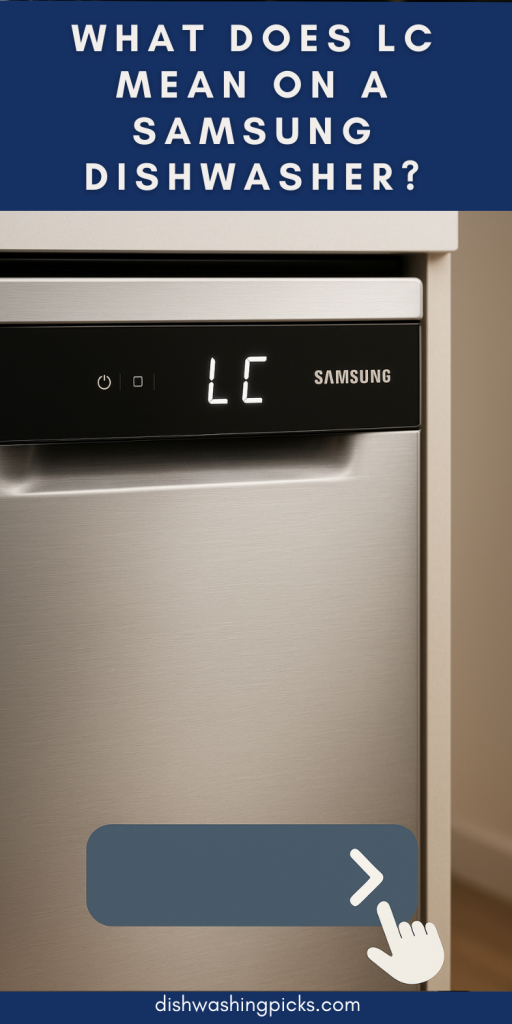
So, you’re staring at your Samsung dishwasher’s display and there it is: “LC.” You might be thinking, “Uh-oh, did I just break it? Is it time to call a repair person?” Before you grab that phone, let’s decode this little mystery together.
Ever felt like your dishwasher has its own secret language? Well, “LC” is one of those dishwasher hieroglyphics — but don’t worry, it’s not as cryptic as it sounds. Imagine this: your dishwasher is basically saying, “Hey, I’m thirsty! Give me some water, please.”
Yep, that’s right. “LC” stands for Leakage Code or Leakage Circuit—a safety alert telling you there might be water leaking inside the machine. It’s the dishwasher’s way of saying, “Something’s up, better pause and check me out.”
What Causes the “LC” Code to Appear?
So, why does your Samsung dishwasher suddenly flash “LC” like it’s throwing up a red flag? There are a few usual suspects:
- Water Leak Detected: The dishwasher has sensors that pick up if water is leaking inside the base. This could be from a cracked hose, loose connections, or even a worn-out seal.
- Blocked Drain or Filter: Sometimes, gunk or food debris clogs the drain, causing water to back up and trigger the leak sensor.
- Internal Tank Issues: If the inner tub or sump has damage or cracks, water can seep where it shouldn’t.
- Door Seal Problems: A faulty or dirty door gasket might let water escape during the wash cycle.
Basically, your dishwasher is trying to protect itself (and your kitchen floor!) by shutting down before a small leak becomes a big mess.
How to Fix the “LC” Code Without Breaking a Sweat
Before you start panicking or calling a technician, here are some quick and easy checks you can do yourself:
- Unplug the Dishwasher: Safety first! Always disconnect power before poking around.
- Check for Standing Water: Pull out the bottom rack and look inside. Is there water pooled at the base? If yes, grab some towels and soak it up.
- Inspect the Door Seal: Give the rubber gasket a once-over. Is it cracked, dirty, or worn out? Wipe it down or replace it if needed.
- Look for Visible Leaks: Check hoses under your sink and behind the dishwasher. Tighten any loose clamps and look for cracks.
- Clear the Filter and Drain: Food debris can cause clogs. Remove and clean the filter and drain area thoroughly.
- Dry Out the Base: If the base pan (where the leak sensor sits) is wet, use a sponge or cloth to dry it completely.
Once you’ve done these, plug the dishwasher back in and see if the “LC” light goes away. Fingers crossed!
When to Call in the Pros
If you’ve tried all the above and that stubborn “LC” code keeps flashing, it might be time to call in a technician. Some leaks or sensor issues require expert tools and know-how — plus, you don’t want to risk water damage or electrical issues.
Also, if you notice any of these:
- Water pooling outside the dishwasher
- Strange noises during the wash cycle
- Dishwasher not draining properly
…those are signs that the problem might be more serious.
Keep Your Dishwasher Happy: Tips to Avoid the “LC” Code
Imagine this: your dishwasher is like a little hardworking robot friend that just wants to do its job well. Here’s how to keep it happy and leak-free:
- Regularly clean filters and drains (once a month is a good rule of thumb).
- Avoid overloading or blocking spray arms.
- Inspect door seals and hoses occasionally for wear and tear.
- Use dishwasher-safe detergents to prevent residue buildup.
- Run hot water through the sink before starting the dishwasher to help it fill properly.
Try thinking of it as a mini spa treatment for your dishwasher — and it’ll thank you by working smoothly for years.
Wrapping It Up
So there you have it — that little “LC” code isn’t a doom signal but a helpful heads-up. With a bit of TLC and some detective work, you can often fix it yourself and keep your Samsung dishwasher running like a champ.
Next time “LC” pops up, don’t sweat it. Just think of it as your dishwasher politely asking for a little attention. And hey, if all else fails, a pro is just a call away!
